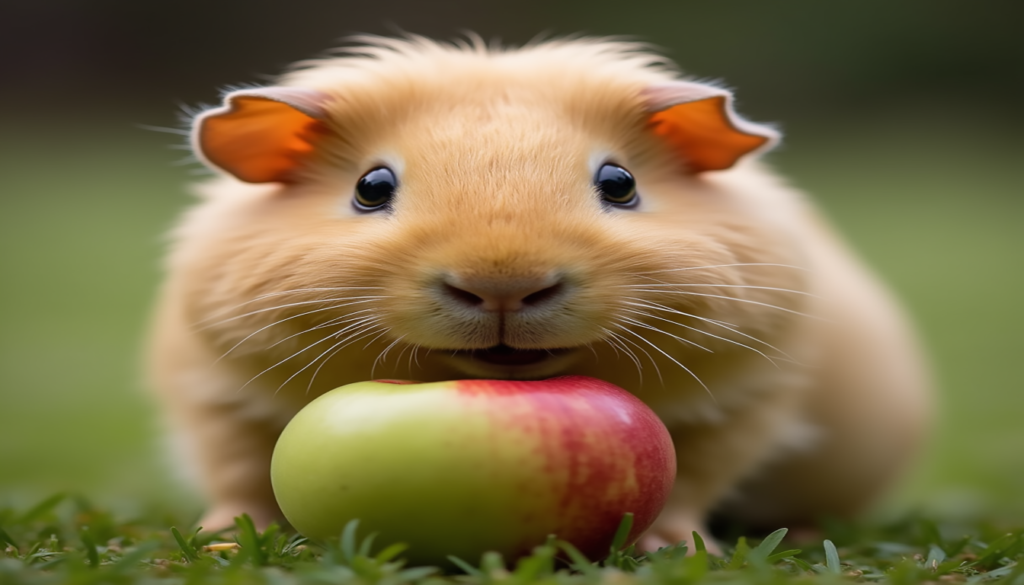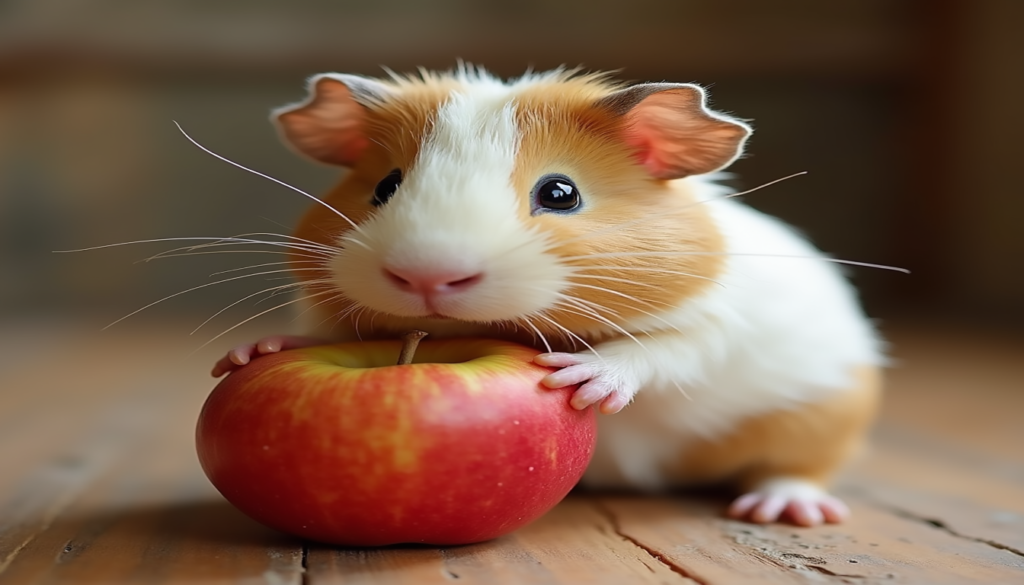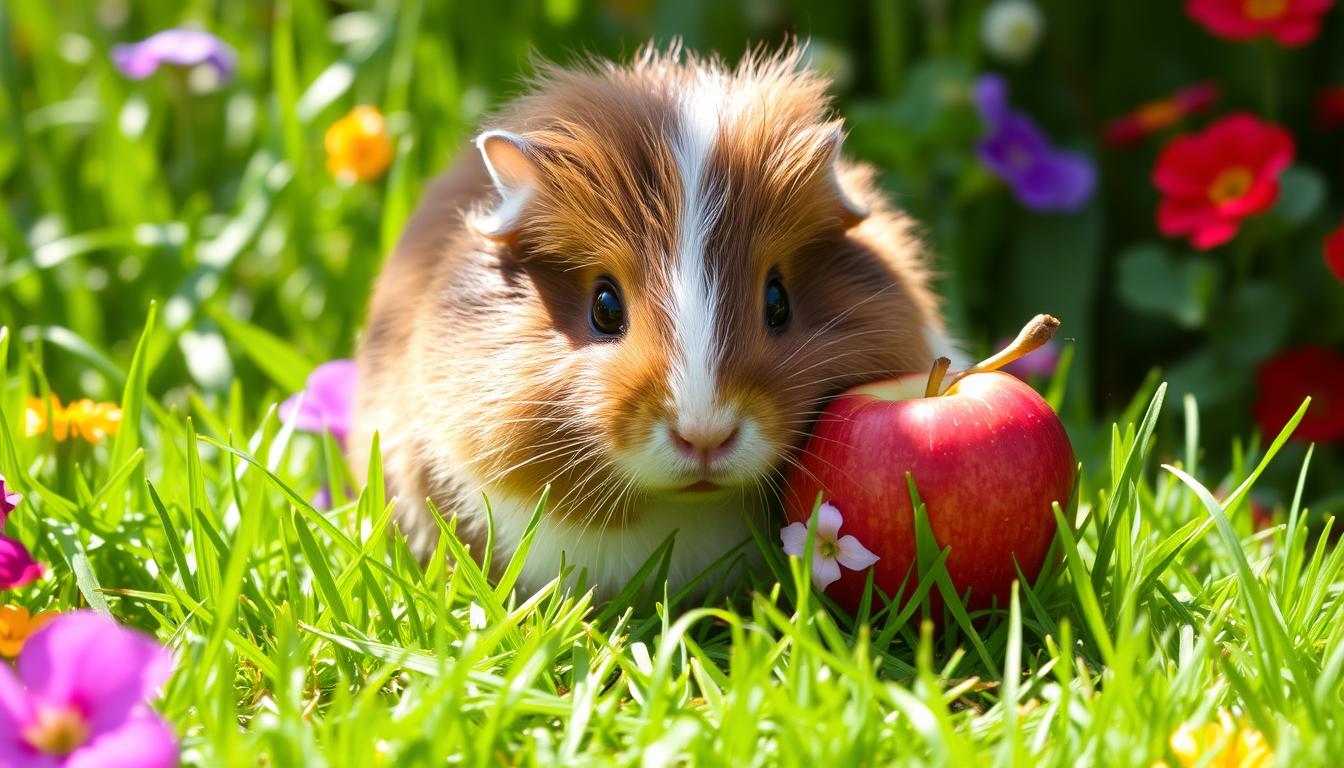
Are you wondering if can guinea pigs eat apples? Yes, they can, but with some care. These cute pets need special food, and apples can be a tasty treat. Since guinea pigs can’t make vitamin C, apples are key to their diet.
Feeding apples to guinea pigs means knowing how much to give and the risks. Apples are good for them, but they have sugar. So, it’s all about giving them just the right amount to keep them healthy.
Are apples safe for guinea pigs? Yes, if you give them the right amount and prepare them right. Knowing how much to give and the possible dangers is important for taking good care of your pet.
Table of Contents
Understanding the Nutritional Value of Apples for Guinea Pigs
Apples are more than just a tasty treat for your furry friend. They offer several nutritional benefits when added carefully to a guinea pig’s diet. These benefits can support your pet’s overall health.
Essential Vitamins and Minerals
Apples provide crucial nutrients that can complement your guinea pig’s diet. They are particularly rich in:
- Vitamin C – critical for guinea pigs who cannot produce this vitamin naturally
- Vitamin A for eye health
- Potassium for muscle and nerve function
Guinea pigs need 10 mg of vitamin C daily per 2.2 pounds of body weight. Apples can help meet this nutritional requirement.
Fiber Content and Digestive Benefits
The benefits of apples for guinea pigs extend to digestive health. Apples contain dietary fiber that supports:
- Healthy gut movement
- Improved digestion
- Balanced intestinal bacteria
Sugar Content Considerations
| Apple Type | Sugar Content | Recommended Frequency |
|---|---|---|
| Red Apples | High | 1-2 times per week |
| Green Apples | Lower | 1-2 times per week |
While apples offer nutrition, their high sugar content means they should be a limited part of your guinea pig’s diet. Experts recommend that apples should make up less than 5% of their total nutritional intake.
“Moderation is key when introducing apples to your guinea pig’s diet.” – Veterinary Nutrition Experts
Safety Precautions When Feeding Apples
Feeding apples to guinea pigs can be a fun treat, but it’s important to do it safely. Apples are tasty, but they need to be given carefully and in small amounts.
Apple seeds are a big no-no. They have a compound called amygdalin that can turn into cyanide. Make sure to remove all seeds before giving apples to your guinea pig to avoid any harm.
“Prevention is always better than cure when it comes to your guinea pig’s nutrition.” – Veterinary Nutrition Expert
- Always remove apple seeds completely
- Wash apples thoroughly to eliminate pesticide residues
- Check for any signs of decay or mold
- Cut apples into small, manageable pieces
Choose organic apples to reduce chemical intake. Cut them into ½-inch cubes and give only 1-2 small pieces twice a week. This keeps your guinea pig’s diet balanced and prevents digestive problems from eating too much.
Baby guinea pigs should wait until they are at least 6 months old before trying apple treats. For older or overweight guinea pigs, talk to your vet about how much to feed them.
Remember, treats like apples should make up no more than 10% of your guinea pig’s daily food. Their main diet should be about 80% high-quality hay, with fresh veggies and a little bit of pellets.
The Right Serving Size and Frequency
Feeding apples to guinea pigs needs careful attention to portion size and how often. These treats should be given in moderation to keep your pet healthy.
When giving apples to your furry friend, use small, precise amounts. A good serving is about 1/2 inch of apple slice. Give it only once or twice a week.
Weekly Portion Guidelines
- Maximum apple serving: 1/2 inch slice
- Frequency: 1-2 times per week
- Remove seeds and core completely
- Always wash apples thoroughly
Signs of Overfeeding
Look out for these signs that you’re giving too many treats:
- Digestive changes
- Decreased appetite for regular food
- Soft or unusual stool
- Weight gain
Best Times to Offer Apple Treats
Timing your apple treats right can make your guinea pig’s diet better and strengthen your bond. Give apple slices during:
- Quiet interaction times
- After regular meal consumption
- During gentle handling sessions
“Moderation is key when feeding apples to guinea pigs. Treats should complement, not replace, their primary diet.”
| Treat Type | Serving Size | Frequency |
|---|---|---|
| Apple Slice | 1/2 inch | 1-2 times/week |
| Hay | Unlimited | Daily |
| Pellets | 1/8 cup | Daily |
Remember, every guinea pig is different. Always watch how your pet reacts to new treats. Also, talk to a vet for advice on what’s best for your pet’s diet.
How to Properly Prepare Apples for Guinea Pigs
Learning how to prepare apples for guinea pigs is key for their health. It’s important to handle their food carefully to avoid health risks. This is a crucial part of guinea pig care.
- Wash the apple thoroughly under cool running water
- Choose organic apples when possible to reduce pesticide exposure
- Remove the core and seeds completely
- Cut the apple into small, bite-sized cubes
“Proper preparation is the key to safely introducing apples into your guinea pig’s diet.”
The critical safety steps include:
- Seed Removal: Apple seeds contain harmful cyanide compounds dangerous to guinea pigs
- Size Matters: Cut pieces should be no larger than ½-inch cubes
- Frequency Control: Serve only 1-2 times weekly
Understanding the nutritional value of apples is important. A quarter-sized apple piece has 18 calories. It also has potassium and vitamin C, which are good for guinea pigs.
For storage, keep apple pieces in the fridge for up to 24 hours. This keeps them fresh and prevents bacteria. Always watch your guinea pig after introducing new foods to make sure they like it.
Different Types of Apples for Guinea Pigs
Apples are a tasty and healthy treat for guinea pigs. Not all apples are the same. Knowing the differences helps you pick the best one for your pet.
Guinea pigs can enjoy apples, but it’s important to choose the right kind. This ensures they stay healthy and happy. Let’s look at the different apple options for your small friend.
Red vs. Green Apples
Red and green apples are both safe for guinea pigs if prepared right. Each has its own special qualities:
- Red Apples: Sweet and soft
- Green Apples: Tart and firmer
Organic vs. Conventional Options
Opt for organic apples for your guinea pig. Non-organic apples may have pesticides that can upset their stomachs.
| Apple Type | Sugar Content | Pesticide Risk | Recommended Frequency |
|---|---|---|---|
| Organic Red Apples | Moderate | Low | 1-2 times per week |
| Organic Green Apples | Low | Low | 1-2 times per week |
| Conventional Apples | Moderate to High | High | Not recommended |
Seasonal Apple Varieties
Throughout the year, different apple types come out. Some favorites for guinea pigs are Gala, Fuji, and Honeycrisp. Remember, fruits should only make up about 10% of their diet.
“Moderation is key when introducing any new fruit to your guinea pig’s diet.” – Veterinary Nutrition Expert
Always wash apples well, take out seeds and stems, and cut them into small pieces. This prevents choking.
Apple Parts: What’s Safe and What’s Not

When thinking about are apples safe for guinea pigs, knowing which parts are okay is key. Not every part of the apple is good for your furry friend’s diet.
Guinea pigs can eat some apple parts but should avoid others. It’s all about picking the right apple parts and preparing them carefully.
Safe Apple Parts
- Apple flesh (meat)
- Apple skin (with proper washing)
Dangerous Apple Components
- Apple seeds
- Apple stems
- Apple core
Apple seeds have a bit of cyanide, which is bad for small animals like guinea pigs. Even a little can be harmful.
“Prevention is always better than cure when feeding your guinea pig.” – Veterinary Nutrition Expert
| Apple Part | Safety Status | Recommended Action |
|---|---|---|
| Flesh | Safe | Cut into small pieces |
| Skin | Safe | Wash thoroughly |
| Seeds | Unsafe | Remove completely |
| Stems | Unsafe | Discard |
Always remove seeds and stems before offering apple slices to your guinea pig. Wash the apple thoroughly to eliminate potential pesticide residues.
By following these guidelines, you can safely add apples as an occasional treat for your guinea pig’s diet.
Health Benefits and Potential Risks
Understanding the benefits of apples for guinea pigs is important. They offer health advantages but also have risks. Pet owners need to think about these carefully.
Vitamin C Advantages
Apples can help boost your guinea pig’s vitamin C levels. Since they can’t make their own, apples are a good supplement. A single slice has enough vitamin C to support their immune system and health.
- Supports immune function
- Helps prevent scurvy
- Promotes healthy skin and coat
Possible Digestive Challenges
The main risk of apples for guinea pigs is their sugar. Eating too much can cause:
- Diarrhea
- Bloating
- Stomach discomfort
Long-term Health Considerations
When giving apples to your guinea pig, moderation is key. Small amounts can help avoid health problems. This way, your pet can still enjoy this tasty treat.
| Nutritional Aspect | Impact on Guinea Pigs |
|---|---|
| Vitamin C Content | Beneficial in small amounts |
| Sugar Content | Potential digestive risks |
| Recommended Frequency | 1-2 small slices weekly |
“A balanced approach to treats can support your guinea pig’s health and happiness.” – Veterinary Nutrition Experts
Always talk to a vet to make sure your guinea pig gets the right food. Every pet is different and may need different things.
Integrating Apples into Your Guinea Pig’s Diet

Creating a balanced diet for your guinea pig is important. Apples can be a tasty treat when added carefully.
Here are some tips for feeding apples to your guinea pig:
- Apples should be an occasional treat, not a dietary staple
- Limit fruit intake to 1-2 small pieces, 2-3 times per week
- Always remove seeds and stems before serving
- Cut apples into small, bite-sized pieces
Your guinea pig’s diet should mainly be hay, making up 80-90% of their food. Apples can be a healthy addition to their diet.
| Diet Component | Percentage | Frequency |
|---|---|---|
| Hay | 80-90% | Unlimited |
| Pellets | 5-10% | Daily |
| Vegetables | 5-10% | 1-2 cups daily |
| Fruits (like Apples) | 2-5% | 2-3 times weekly |
Start with small amounts of apples when introducing them. Watch for any signs of upset stomach or other issues. Gradual introduction is key to preventing potential health issues.
“Nutrition is the foundation of your guinea pig’s health and happiness” – Veterinary Nutrition Experts
While apples offer vitamins and fiber, they should not replace hay and fresh veggies in your guinea pig’s diet.
Alternative Fruits for Guinea Pigs
Looking into other fruits for guinea pig treats can make their diet more interesting and nutritious. While apples are a good choice, many other fruits offer important vitamins and minerals.
Remember, it’s important to give fruits in moderation. These treats should be given only once or twice a week. This helps avoid too much sugar and health problems.
Safe Fruit Options
- Strawberries: Low in sugar and packed with nutrients
- Blueberries: Rich in antioxidants, limited to 1-2 per week
- Watermelon: Hydrating, but serve in small cubes
- Oranges: High in Vitamin C, offer in moderation
Each fruit adds something special to your guinea pig’s diet. The trick is to introduce them carefully and watch how your pet reacts.
Fruit Feeding Guidelines
| Fruit | Serving Frequency | Nutritional Benefit |
|---|---|---|
| Bananas | Thin slice, few times weekly | High in potassium |
| Grapes | 1-2 per week | Antioxidants and Vitamin C |
| Pears | Small pieces, once weekly | Fiber and hydration |
“Variety is the spice of life, even for guinea pigs!” – Veterinary Nutrition Expert
Always make timothy hay the main part of their diet. Use fruits as occasional treats. Keep an eye out for any digestive issues and talk to your vet if you see any problems.
Conclusion
When thinking about if guinea pigs can eat apples, it’s important to understand the details. They can have apples as an occasional treat, but it’s important to keep it in moderation. Following good guinea pig care tips helps ensure they get the nutrients they need without health risks.
Apples are a good source of vitamin C, which is key for guinea pigs since they can’t make it themselves. But, make sure to remove seeds and cores, and only give them a little bit at a time. This way, you can give them a special treat without making it a regular part of their diet.
Every guinea pig is different. Some might love apple treats, while others might not. Watch how your pet reacts and make sure they’re digesting it well. Always remember to give them a balanced diet with hay, pellets, and fresh veggies. This will keep them happy and healthy.
Adding apples to your guinea pig’s diet needs knowledge, patience, and careful watching. By following these tips, you can give them a tasty and nutritious treat. This will make their meals more enjoyable and help keep them healthy.
FAQ
Can guinea pigs eat apples safely?
Yes, guinea pigs can eat apples, but only in small amounts. Apples are good for them because they have vitamin C. But, they should only have apples as an occasional treat because of the sugar.
Always take out the seeds and core before giving them apples. Start with a little bit to see how they like it.
How often can I feed my guinea pig apples?
Give your guinea pig 1-2 small pieces of apple once or twice a week. This keeps the sugar intake low and helps avoid digestive problems. It also gives them some good nutrients.
Are apple seeds dangerous for guinea pigs?
Yes, apple seeds are bad for guinea pigs. They have amygdalin, which turns into cyanide when digested. Make sure to remove all seeds and core before giving them any apple.
What type of apples are best for guinea pigs?
Choose organic apples to avoid pesticides. Both red and green apples are okay, but organic ones are safer and more nutritious for your guinea pig.
How should I prepare apples for my guinea pig?
First, wash the apple well. Then, remove the seeds and stem. Cut it into small cubes, about 1/2 inch in size. This size is safe and easy for them to eat.
Opt for organic apples and make sure they’re not too big to prevent choking.
Can guinea pigs eat apple skin?
Yes, apple skin is safe and has extra nutrients and fiber. Just make sure to wash the apple well to remove any pesticides.
What are signs my guinea pig has eaten too many apples?
Look out for signs like diarrhea, less appetite, bloating, or changes in their stool. These could mean they’ve had too much apple or it was introduced too fast.
Are there alternative fruits I can feed my guinea pig?
Yes, you can give them strawberries, blueberries, and a little bit of melon. But, introduce new fruits slowly and in small amounts to avoid upset stomachs.
Do guinea pigs need vitamin C from apples?
While apples have vitamin C, they shouldn’t be the main source. Guinea pigs need vitamin C all the time. The best way to give it to them is through special pellets and fresh veggies.
How do I store cut apples for my guinea pig?
Keep cut apple pieces in an airtight container in the fridge for up to 24 hours. Always check them before feeding to make sure they’re not spoiled or brown.

